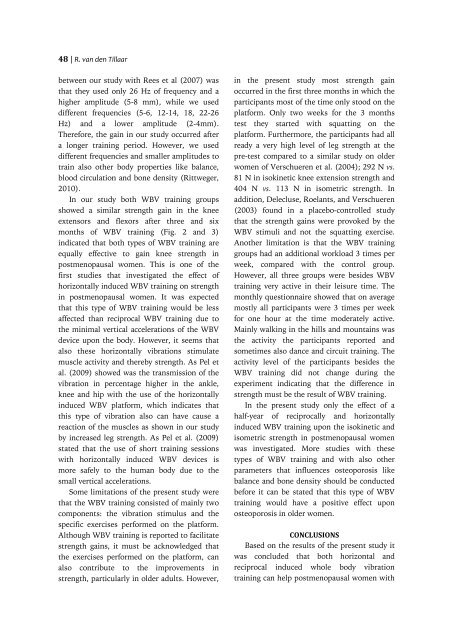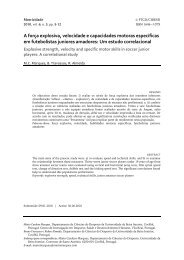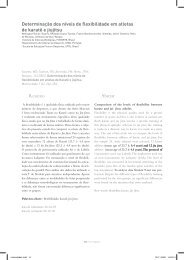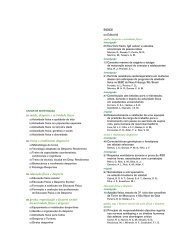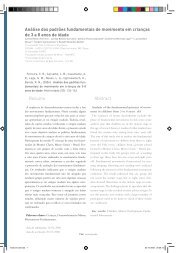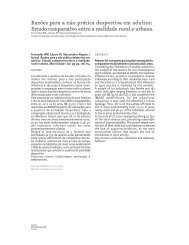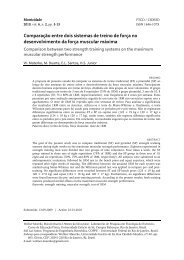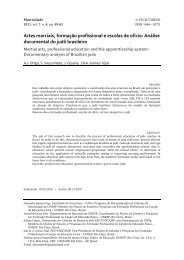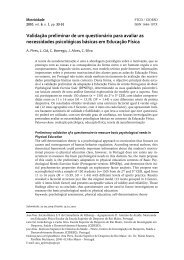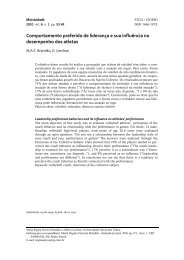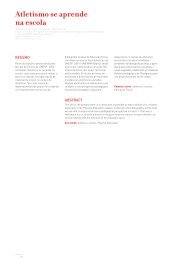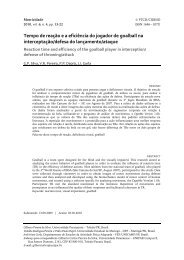revista motricidade
revista motricidade
revista motricidade
- No tags were found...
Create successful ePaper yourself
Turn your PDF publications into a flip-book with our unique Google optimized e-Paper software.
48 | R. van den Tillaar<br />
between our study with Rees et al (2007) was<br />
that they used only 26 Hz of frequency and a<br />
higher amplitude (5-8 mm), while we used<br />
different frequencies (5-6, 12-14, 18, 22-26<br />
Hz) and a lower amplitude (2-4mm).<br />
Therefore, the gain in our study occurred after<br />
a longer training period. However, we used<br />
different frequencies and smaller amplitudes to<br />
train also other body properties like balance,<br />
blood circulation and bone density (Rittweger,<br />
2010).<br />
In our study both WBV training groups<br />
showed a similar strength gain in the knee<br />
extensors and flexors after three and six<br />
months of WBV training (Fig. 2 and 3)<br />
indicated that both types of WBV training are<br />
equally effective to gain knee strength in<br />
postmenopausal women. This is one of the<br />
first studies that investigated the effect of<br />
horizontally induced WBV training on strength<br />
in postmenopausal women. It was expected<br />
that this type of WBV training would be less<br />
affected than reciprocal WBV training due to<br />
the minimal vertical accelerations of the WBV<br />
device upon the body. However, it seems that<br />
also these horizontally vibrations stimulate<br />
muscle activity and thereby strength. As Pel et<br />
al. (2009) showed was the transmission of the<br />
vibration in percentage higher in the ankle,<br />
knee and hip with the use of the horizontally<br />
induced WBV platform, which indicates that<br />
this type of vibration also can have cause a<br />
reaction of the muscles as shown in our study<br />
by increased leg strength. As Pel et al. (2009)<br />
stated that the use of short training sessions<br />
with horizontally induced WBV devices is<br />
more safely to the human body due to the<br />
small vertical accelerations.<br />
Some limitations of the present study were<br />
that the WBV training consisted of mainly two<br />
components: the vibration stimulus and the<br />
specific exercises performed on the platform.<br />
Although WBV training is reported to facilitate<br />
strength gains, it must be acknowledged that<br />
the exercises performed on the platform, can<br />
also contribute to the improvements in<br />
strength, particularly in older adults. However,<br />
in the present study most strength gain<br />
occurred in the first three months in which the<br />
participants most of the time only stood on the<br />
platform. Only two weeks for the 3 months<br />
test they started with squatting on the<br />
platform. Furthermore, the participants had all<br />
ready a very high level of leg strength at the<br />
pre-test compared to a similar study on older<br />
women of Verschueren et al. (2004); 292 N vs.<br />
81 N in isokinetic knee extension strength and<br />
404 N vs. 113 N in isometric strength. In<br />
addition, Delecluse, Roelants, and Verschueren<br />
(2003) found in a placebo-controlled study<br />
that the strength gains were provoked by the<br />
WBV stimuli and not the squatting exercise.<br />
Another limitation is that the WBV training<br />
groups had an additional workload 3 times per<br />
week, compared with the control group.<br />
However, all three groups were besides WBV<br />
training very active in their leisure time. The<br />
monthly questionnaire showed that on average<br />
mostly all participants were 3 times per week<br />
for one hour at the time moderately active.<br />
Mainly walking in the hills and mountains was<br />
the activity the participants reported and<br />
sometimes also dance and circuit training. The<br />
activity level of the participants besides the<br />
WBV training did not change during the<br />
experiment indicating that the difference in<br />
strength must be the result of WBV training.<br />
In the present study only the effect of a<br />
half-year of reciprocally and horizontally<br />
induced WBV training upon the isokinetic and<br />
isometric strength in postmenopausal women<br />
was investigated. More studies with these<br />
types of WBV training and with also other<br />
parameters that influences osteoporosis like<br />
balance and bone density should be conducted<br />
before it can be stated that this type of WBV<br />
training would have a positive effect upon<br />
osteoporosis in older women.<br />
CONCLUSIONS<br />
Based on the results of the present study it<br />
was concluded that both horizontal and<br />
reciprocal induced whole body vibration<br />
training can help postmenopausal women with


